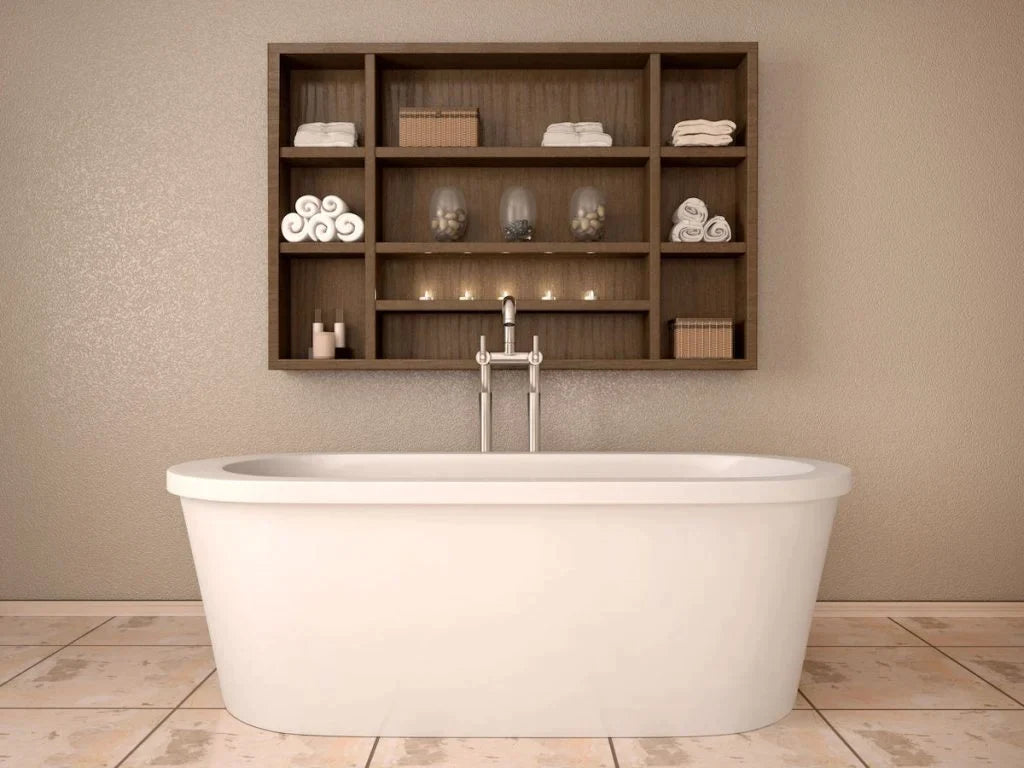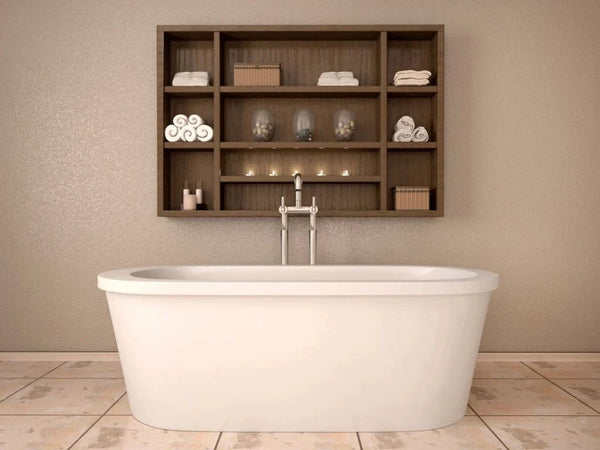Marie Kondo’s organization method helps people purge unnecessary items and cut through clutter to create more room for daily joy. From donating old clothes to thrift stores to keeping dishes out of the sink, there are endless ways to instill Kondo’s methods.
Still, many people are unsure how to apply these principles to the bathroom — one of the smallest (and often most cluttered rooms) in the home. Fortunately, we’ve rounded up a list of expert tips and tricks on minimizing and organizing the bathroom.
How Marie Kondo’s Philosophy Works
The KonMari Method was first pioneered by Marie Kondo in 2011, with her book “The Life-Changing Magic of Tidying Up.” This self-help title is all about tidying up to reduce distressing emotions and create more joy. According to Kondo’s website, the method “encourages tidying by category – not by location – beginning with clothes, then moving on to books, papers, komono (miscellaneous items), and, finally, sentimental items.”
This process has garnered attention because it is in contrast to how most of the western world lives. We’re used to acquiring items and buying things in order to feel wealthy and abundant. Kondo’s method challenges this idea by asking people to find more satisfaction and joy in owning less.
Moving through Marie Kondo’s method starts with asking yourself a simple question, explains Cate La Farge Summers at One Kings Lane, and that is: Does it spark joy?
It’s important to think about every single thing you own, according to the categories outlined above. If it doesn’t spark joy, then it’s time to say goodbye to that item and give it a new life. Once these items have been cleared from your home, only the items that truly give joy should remain and can be placed back intentionally, where everything is visible. This way, they’re accessible to reach and easy to put back.
This process is aimed at helping homeowners achieve the nirvana of housekeeping. By maintaining everything in its own designated place, cleaning as we know it won’t be necessary. This is an especially important philosophy for the bathroom, which tends to attract clutter in the form of toiletries, makeup, towels and other items that are used on a daily or weekly basis.

Tidying Up Your Bathroom
Kondo’s method can feel both overwhelming and exciting. But before you start purging everything in sight, make sure you have a plan. “If you haven’t done a major purge in a long time, make sure you have several days to devote to this project and that you’re rested and free of distractions. Think of it as preparing for a move; it’s easier when you’re not rushing or multi-tasking,” suggests Johnna Kaplan at The Spruce.
Also remember that this process might be emotional — even if it’s just one small bathroom you’re tidying up.
“Kondo says that we hold onto things for one of two emotional reasons—a fear of the future or to preserve the past,” writes Alexandra Churchill at Martha Stewart Living. In recognizing your emotional attachment to physical items, you can be released of feelings like guilt and shame that are sometimes associated with nostalgic items.
Tidying up the bathroom can help you realize that you have full control over everything you own. This means you have the power to purge things that don’t bring you joy (and keep those that do).
If you’re skeptical about how tidying up the bathroom can impact your life outside the home, consider a point from author and women’s health expert Dr. Christiane Northrup. She explains that clutter in the home can be representative of psychological clutter and mental blockages.
Clutter in a person’s living room or kitchen can be interpreted to mean they’re hiding themselves from the world, for example. Meanwhile, clutter in hallways can symbolize that a person’s life path isn’t clearly defined or well-planned. Clutter in the bathroom also has personal indications. “The bathroom is where we pamper ourselves and prepare to face the world. Think about all the products under your sink that you never use. Clutter in this room may mean you lack self-worth,” Northrup explains.
Thinking about the psychological benefits may inspire you to take on this challenging but rewarding organizing feat.
Purging Cosmetics and Toiletries
The first step in decluttering the bathroom is purging items no longer needed. This can be a difficult step because there are likely things that you think you need. However, they may simply be there because you’re accustomed to seeing them everyday.
Blogger Amanda Hendrix at Love and Renovations explains how she overcame this challenge when cleaning out her kitchen and bathroom. “There are a lot of things that seem to just be in my house out of habit. I’ve gotten used to them being there, they serve no purpose, and I just haven’t gotten around to donating them,” she writes.
Usually, she kept these things around just because they seemed practical. With Kondo’s method, however, Hendrix realized the value of purging the things that just don’t get used. Once she embraced this mindset, she realized that her bathroom and the rest of her home were filled with items that aren’t being used.
And getting rid of some products can actually be good for you physically. The team at skincare company Biotherm say old cosmetics can actually be irritating for the skin. Things that have been open for a long time or haven’t been used in a while may be past their expiration date. Check product containers for expiry dates; generally, products that are older than a year should be tossed.
Unused cosmetic samples and soaps can usually be thrown away, rather than donated, if they haven’t been used. Even though it seems like they’ll be useful at some point, you’re likely not going to use them if you haven’t already. In her detailed account of purging with the KonMari method, GQ contributor Nicole Silverberg says she got rid of toothpaste samples from the dentist as well as expired medicine in the cabinet. She was interested to discover that some momentos she’d been holding onto didn’t actual have that much meaning anymore, and she was able to discard them.

Choosing Organizational Containers
The containers you use to store things also play an important role in keeping things organized and accessible. For example, Laura Gaskill at Houzz says glass apothecary jars are attractive storage options for supplies like cotton balls and cotton swabs. In contrast, zippered pouches are great for keeping together items like makeup, skin care products and hair accessories. Anything that will spill or leak should be kept out of these pouches and bags, however, as this can lead to more mess and clutter.
One example of Kondo’s method in action can be found in a roundup by Allie Merriam at PopSugar. The image shows how items are organized by category and placed into the proper vessel when necessary. The top shelf holds bulk soap and cleaning supplies, while the second shelf down holds spray bottles, smaller bottles of cleaner and essential oils. Finally, the bottom shelf has a designated box for first aid and another box for body oils.
Once you’ve decided which organizational containers you’re using (and how they’ll stack up on shelves and cabinets), you can think about storage strategies. Kondo has her own method of stacking clothing so that it’s all accessible in the same drawer. Architectural Digest’s Amanda Sims explains that this allows you to see everything at once so you can take an inventory of what you own. The same strategy works for bathroom linens, including body towels, hand towels, bath mats and extra curtains.
While Kondo’s method is intended to clean up your clutter for good, it isn’t a quick or easy process.
“If you are truly going to use the KonMari method and successfully ‘graduate’ her course, you'll have to set aside a good chunk of time to do so,” adds Caitlin Harper at Insider. Creating your own version of joy can help you create an organization method that works for you personally, even if it doesn’t always echo Kondo’s tips word for word.
Images by: Igor Zakharevich/©123RF.com, Kinkate, Madison Inouye






